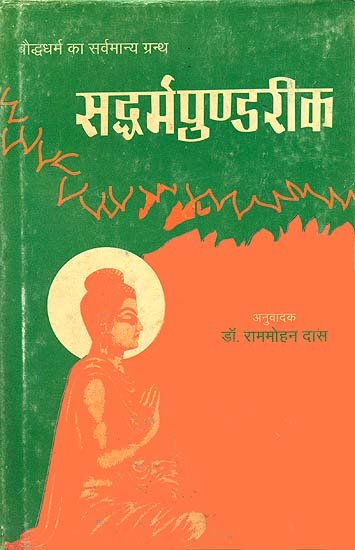Lotus Sutra (Saddharma-Pundarika) [sanskrit]
by H. Kern | 2013 | 16,351 words | ISBN-13: 9788120801226
The Lotus Sutra (Saddharma-pundarika) is an important Mahayana Buddhist scripture classified as one of the nine Dharmas. the Lotus Sutra deals with a wide range of important Buddhist teachings in twenty-seven chapters including the nature of the Buddhas and the inherent potentiality of becoming Buddha within all beings. This editions only contains the Sanskrit metrical text and the corresponding English translation. Alternative titles: Saddharma-puṇḍarīka-sūtra (सद्धर्म-पुण्डरीक-सूत्र).
Verse 16.36
अध्याशयेन संपन्नाः श्रुताधाराश्च ये नराः ।
संधाभाष्यं विजानन्ति काङ्क्षा तेषां न विद्यते ॥ ३६ ॥
adhyāśayena saṃpannāḥ śrutādhārāśca ye narāḥ |
saṃdhābhāṣyaṃ vijānanti kāṅkṣā teṣāṃ na vidyate || 36 ||
Those who are possessed of firmness of intention and have learnt the principles, will understand the mystery and feel no uncertaint.
English translation by H. Kern (2013) Buy now!
Glossary of Sanskrit terms
Note: This extracts Sanskrit terms and links to English definitions from the glossary, based on an experimental segmentation of verse (16.36). Some terms could be superfluous while some might not be mentioned. Click on the word to show English definitions.
Adhyashaya, Sampanna, Shrutadhara, Yah, Yat, Nara, Sandhabhashya, Vijanat, Kanksha, Tad,
Analysis of Sanskrit grammar
Note: this is an experimental feature and only shows the first possible analysis of the Sanskrit text (Lotus Sutra Verse 16.36). If the system was successful in segmenting the sentence, you will see of which words it is made up of, generally consisting of Nouns, Pronouns, Verbs, Participles and Indeclinables. Click on the link to show all possible derivations of the word.
- Line 1: “adhyāśayena saṃpannāḥ śrutādhārāśca ye narāḥ ”
- adhyāśayena -
-
adhyāśaya (noun, masculine)[instrumental single]
- sampannāḥ -
-
sampanna (noun, masculine)[nominative plural], [vocative plural]sampannā (noun, feminine)[nominative plural], [vocative plural], [accusative plural]
- śrutādhārāś -
-
śrutādhāra (noun, masculine)[nominative plural], [vocative plural]
- ca -
-
ca (indeclinable conjunction)[indeclinable conjunction]ca (noun, masculine)[compound], [vocative single]ca (noun, neuter)[compound], [vocative single]
- ye -
-
ya (noun, masculine)[nominative plural]yā (noun, feminine)[nominative dual], [accusative dual]yaḥ (pronoun, masculine)[nominative plural]yat (pronoun, neuter)[nominative dual], [accusative dual]yā (pronoun, feminine)[nominative dual], [accusative dual]
- narāḥ -
-
nara (noun, masculine)[nominative plural], [vocative plural]narā (noun, feminine)[nominative plural], [vocative plural], [accusative plural]
- Line 2: “saṃdhābhāṣyaṃ vijānanti kāṅkṣā teṣāṃ na vidyate ”
- sandhābhāṣyam -
-
sandhābhāṣya (noun, neuter)[adverb], [nominative single], [accusative single]
- vijānanti -
-
vijānat (noun, neuter)[nominative plural], [vocative plural], [accusative plural]
- kāṅkṣā -
-
kāṅkṣā (noun, feminine)[nominative single]
- teṣām -
-
tad (noun, neuter)[genitive plural]sa (noun, masculine)[genitive plural]
- na -
-
na (indeclinable particle)[indeclinable particle]na (noun, masculine)[compound], [vocative single]na (noun, neuter)[compound], [vocative single]
- vidyate -
-
√vid (verb class 2)[present passive third single]√vid (verb class 6)[present passive third single]√vid (verb class 7)[present passive third single]
Other editions:
Also see the following editions of the Sanskrit text or (alternative) English translations of the Lotus Sutra Verse 16.36
The Lotus Sutra (The Saddharma-Pundarika)
by H. Kern (2013)
The Lotus Sutra (Text with Hindi Translation)
by Ram Mohan Das (2001)
![Lotus Sutra (Saddharma-Pundarika) [sanskrit] - book cover](/uploads/a/Lotus-Sutra.jpg)
